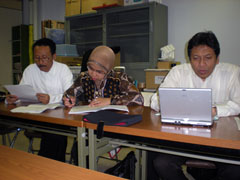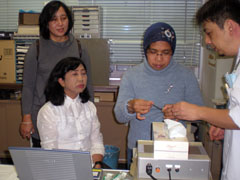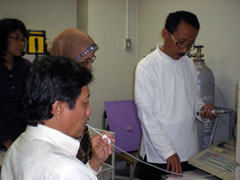Program for halitosis care based on basic researches and clinical studies
|
9 Nov. 2009
| 09:30-10:00 | | Briefing |
| 10:00-11:00 | | Learning on Articles |
| 11:00-12:30 | | Lecture and discussion |
I. Introduction
| a. | Halitosis epidemiology |
| b. | What is halitosis, oral malodor or bad breath odor? |
| 12:30-14:00 | | (Lunch) |
| 14:00-16:00 | | Lecture and discussion |
| c. | Causes of halitosis |
| d. | Oral malodor causes periodontal destruction |
|

Self-learning using published papers on basic science related to halitosis, especially protein metabolic mechanism of anaerobic bacteria, chemistry of volatile sulfide compounds, physiology of olfaction in addition to oral malodor epidemiology. It might be easier for participants to understand because of knowing technical terms before lecture (1st day, morning).
|
|
10 Nov. 2009
| 09:30-10:30 | | Learning on Articles |
| 10:30-12:30 | | Lecture and discussion |
II. Examinations
| a. | Organoleptic measurement |
| b. | Instrumental analysis |
III. Diagnosis
| 12:30-14:00 | | (Lunch) |
| 14:00-15:00 | | Medical and Dental Hospital Tour |
| 15:00-15:30 | | (Break) |
| 15:30-17:00 | | Practice on Examinations in Oral Malodor Clinic, Niigata University Hospital |
|

Participants reviewed 1st day's lecture, and read published papers regarding clinical tests and diagnosis for halitosis patients. For last 10 minutes, they briefly discussed in order to share knowledge gained by each self-learning (2nd day, morning).
|

Practice of organoleptic test: examiner assessed quantitatively and qualitatively patient' s mouth air. We used privacy screen and 6 scale scoring criteria for breath malodor (2nd day, afternoon).
|

Practice: participants tried to measure patients' volatile sulfur compounds in his/her mouth air using gas chromatography in oral malodor clinic, university hospital (2nd day, afternoon).
|
|
|

Patients' mouth air were sampled by 1 mL syringe and hydrogen sulfide, methylmercaptan and dimethyl sulfide were measured by portable gas chromatography (2nd day, afternoon).
|
|
11 Nov. 2009
| 09:30-10:30 | | Learning on Articles |
| 10:30-12:30 | | Lecture and discussion |
IV. Treatment
| a. | Tongue Cleaning |
| b. | Toothpaste, Antimicrobial Mouthwash and Chewing Gum |
| 12:30-14:00 | | (Lunch) |
| 14:00-15:00 | | Lecture and discussion |
| c. | Effect of Non-Antimicrobial products |
| d. | Pseudo-halitosis and Halitophobic patients |
| 15:00-15:30 | | (Break) |
| 15:30-17:30 | | Practice on Treatments in Oral Malodor Clinic, Niigata University Hospital |
| 18:00-21:00 | | (Welcome Dinner) |
|

Participants practiced tongue cleaning using specially designed tongue brush, mouth rinsing with 0.1% zinc chloride solution, and tested 3% protease tablets. In order to assess their treatment effects, volatile sulfur compounds in patients' mouth air were measured by gas chromatography and values were compared between before and after treatments (2nd day, afternoon).
|
|
12 Nov. 2009
| 09:30-12:00 | | General discussion |
|
|
Lecturers in Niigata University:
1. Prof. Hideo Miyazaki
2. Dr. Takayuki Yamaga
3. Dr. Kaname Nohno
4. Dr. Yuka Makino
Participants:
1. Dr. Dewi Agustina, Oral Medicine, University of Gadjah Mada
2. Dr. Bernadetta Esti Chrismawaty, Oral Medicine, University of Gadjah Mada
3. Dr. Ahmad Syaify, Periodontology Department, University of Gadjah Mada
4. Dr. Sri Widiati, Preventive Department, University of Gadjah Mada
5. Dr. Bambang Priyono, Preventive Department, University of Gadjah Mada
6. Dr. Harsini, MS, Biomaterial Department, University of Gadjah Mada
|

